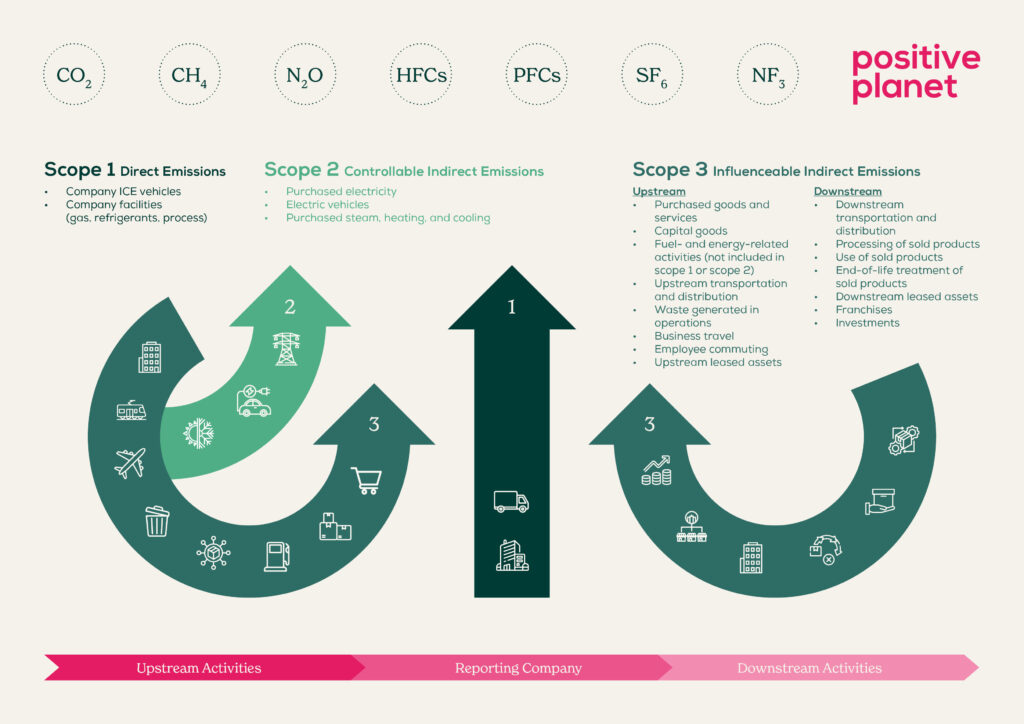A top reason for businesses stalling climate action is a lack of knowledge (63%) about carbon emissions and sustainability. Barriers to engagement often occur as a result of business leaders carrying limited expertise around carbon reduction. Positive Planet works alongside businesses, offering hands-on support and sharing expert knowledge throughout the whole process, adding maximum value to our community members’ carbon reduction experience.
Carbon emissions can be broken down into smaller, easy-to-digest categories, known as scopes. Each scope owns specific company emissions, making them easier to identify and target with carbon reduction methods. Find out more about scope 1, 2, and 3 below.
Scope 1
Scope 1 emissions are categorised as direct emissions that result from sources controlled or owned by an organisation such as fuel usage from the company fleet, energy usage within owned facilities and energy assets, and manufacturing and processing of chemicals and materials.
Your business can directly influence these emissions through organised and progressive actions, like sourcing renewable energy for company premises or investing in an electric fleet to minimise scope 1 emissions.
Scope 2
An organisation’s scope 2 emissions are categorised as indirect emissions that occur from purchased energy sources. More simply put, scope 2 covers the electricity consumed by the end-user for operational activities. This can include purchased electricity, heating, or cooling, usually to power a building or facility. Together with scope 1, these categories typically cover a small portion of your organisational carbon footprint and are often the easiest emissions to tackle.
To minimise scope 2 emissions, business leaders can evaluate the emissions in this category, and switch to low-carbon energy sources, invest in on-site renewable energy, or upgrade outdated heating and cooling systems to maximise energy efficiency.
Scope 3
The largest emissions category, scope 3, can be responsible for up to 90% of your organisational emissions. They account for all other indirect emissions that occur in the value chain of an organisation. They are a by-product of a company’s business activities and are neither owned nor controlled by the organisation, making it challenging to identify and reduce scope 3 emissions, especially if your suppliers are difficult to reach. Positive Planet offers support with engaging your supply chain, you can find out more here.
Common emissions that fall under scope 3 are generated from the processing of, use, and waste disposal of sold products and services, known as upstream and downstream activities, and business travel. Upstream emissions come from the production process of your business’s products and/or services, while downstream emissions arise from their use and disposal.
For example, for an organisation that manufactures products, there will often be significant carbon emissions from the extraction, manufacture and processing of the raw materials that fall into scope 3.
Full disclosure of other emissions included in your scope 3 category can be viewed in Figure 1 below.

Why calculate scope 1, 2, & 3 emissions
Identifying your organisational emissions hotspots in line with scope 1, 2, and 3 categories will help you understand what activities are having the largest impact on your carbon footprint. With this newfound knowledge, you can begin to tackle key areas of your footprint, implementing new low-carbon initiatives and engaging your supply chain to support carbon reductions across your business and value chain.
Measuring and reducing your carbon emissions accelerates profitability and drives business growth. Business leaders understand that environmental sustainability is becoming a critical factor in the tendering process. Despite this, 9 out of 10 B2B businesses are still at significant risk of losing clients or are missing out on winning new business because of a low sustainability score.
At Positive Planet, we work with clients throughout each stage of their decarbonisation journey, educating them during the measurement process with in-depth analysis calls, sharing expertise and best practices to foster growth, mitigate risks, and enable sizable carbon reductions across all scopes.
For more information about scope 1, 2, and 3, or to find out how we can help improve your company’s sustainability score to win new business, chat with our friendly team today.

